Ecorium Development
Since writing about c-blocks back in 2004 on Anargo (which drove Kage nuts 😛 ) and then over on the Black Library forums (which eventually got me banned for a bit, and brought in the orange disclaimer), and a few other places 😀 , the world has moved on. The idea I developed into the Ecorium is starting to come about in the real world, so now I want to push the idea to get ahead of reality once more. Below is my draft of the logical reasons and solutions for each stage of Ecorium developed reaching forward from the present day, through VotNF, all the way to Sciror. These ideas will be blended into the final timeline of the setting later on, when I have the dates sorted, though we have the first date;
The first 'Ecroium' turns up in 2013 in Korea, designed by Samoo Architects & Engineers in collaboration with Grimshaw Architects, and made public around 2010. Nothing to do with me and the name is probably a coincidence (unless someone at British Grimshaw Architects is a massive 40K fan, and that fact the name has 'grim' in it makes me wonder if there is a 40K connection?). However, I now hereby retroactively claim that as part of the first stage in the Ecorium timeline. By serendipity, the Korean Ecorium is based on eco-domes and has research facilities (but still lacks work and living space). So we can fold this into VotNF as stage one, develop the later sages to get us off-world then fold the VotNF timeline into Sciror, then fold the completed concepts into Philhammer. All part of the Philverse concept. So, for Visions of the Near Future;
Stage one - Genesis
Bio-domes of the Edan project, combining research facilities with an artificial ecosystem. The first appearance of the word 'Ecorium' appears on a rabid fanbois website in 2007, the first actual building bearing the name 'Ecorium' being built by Samoo in South Korea: Ecorium of the National Ecological Institute. The term develops over time to include 'work' rather than just 'research' with the development of peripheral support green businesses developed in conjunction with the eco-research and resulting product tested within the bio-domes. However, it is a while before we have non-related businesses inside bio-domes.

Stage two - Britain
Britain builds all over the green belt using the ECORR (Eco Construction Over Road and Rail) housing concept. Land that receives sun and rain is classified under a new eco-development guideline as 'premium land' as it can sustain life, acts as a carbon sink, and has to be preserved at all costs. This concept is combined with a movement to fight back against the old architectural paradigm of building residential and commercial property by the side of the road. A rejection of city planning that is not holistic, and instead seeks to create spaces where people want to live. Though many do not know they want ECORR until they see it. However, when they do see it, it leads to a rejection of the soul-destroying concrete jungles of modernist and collectivist 'European' thinking. All roads and rail systems are multilevel and are covered over with habitable space. Living space is moved to the outer layer, the 'skin', which all have roof gardens. Yep, everyone in an ECORR gains a garden built on the roof of the hab below, and their hab-unit is soundproofed. From a satellite photo, all you see is green space of roof gardens, with parks between ECORR blocks. A green and pleasant land once more. A place of tranquillity in a bustling, hyper-paced, modern world.
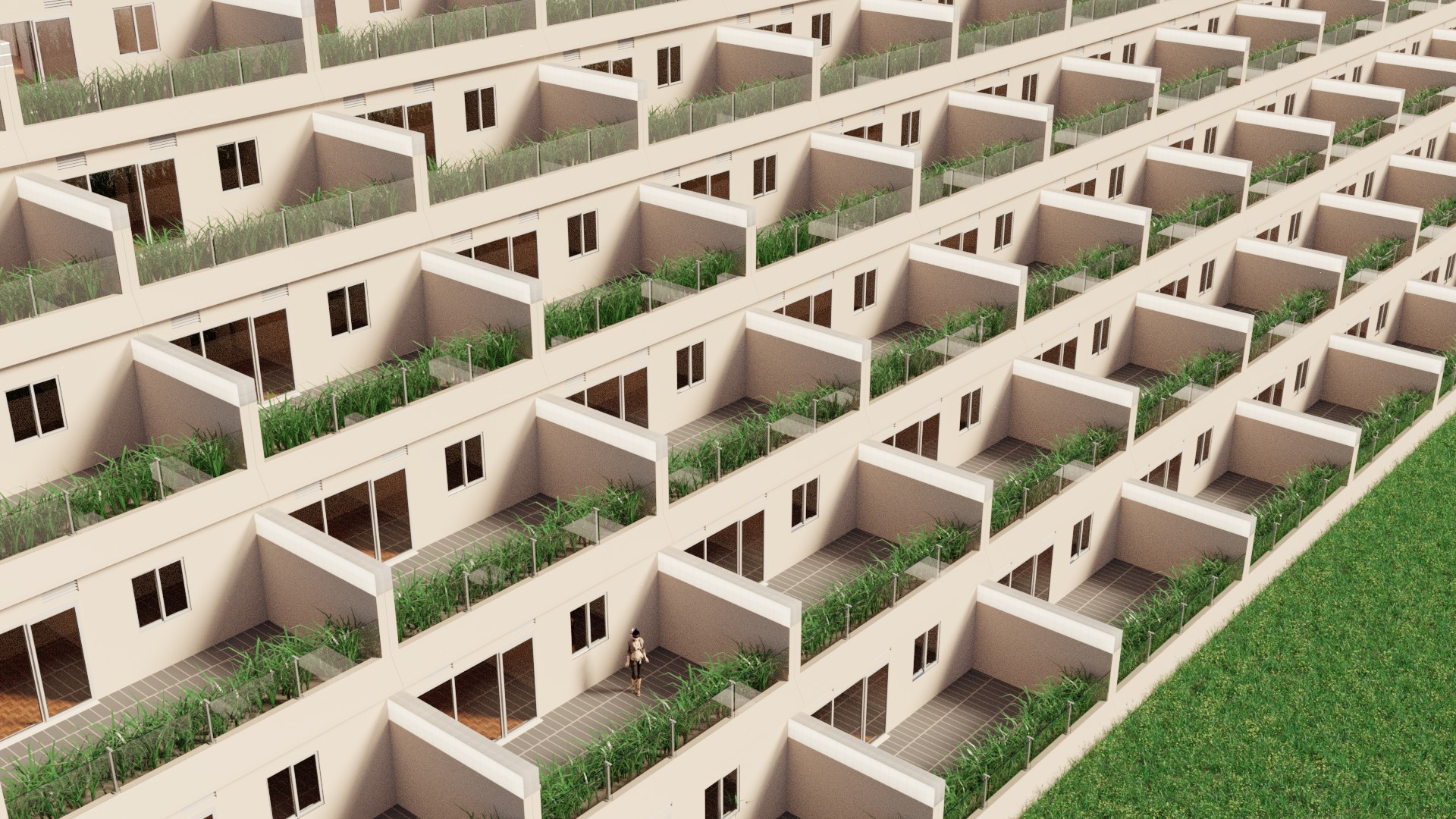
Inside the ECORR is a hive of activity, and contains all the commercial space, co-working spaces, offices, entertainment, gym and other facilities, you'll ever need, all with links to the hidden inner road and transport networks. Co-working spaces and work from home means work comes to you, rather than you travelling to the job. On-site jobs, such as maintenance of an automated factory, is done by remote drone. A worker goes to a co-working space and 'remotes in'. As time progresses these drones take over trivial tasks and only require oversight (guess what those drones are going to turn into?)
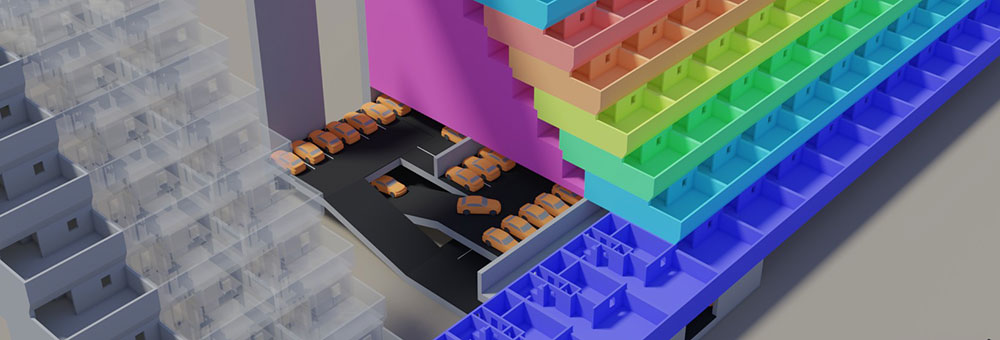
Stage three - The Gulf
Stage one and two are folded into each other. The first true Ecorium are created in the latter half of the 21st century: bio-dome with work and living space combined. (I am not aware of an example as yet on the planet, but it must be coming!). The first examples are built in the Gulf states as they are fantastically expensive. These Ecorium are the brute force terraforming of Earth's desert. Massive drive for self-sufficiency and water capture and recycling. No expense is spared to create a 'green and pleasant land' in the desert. They start out as climate controlled ecotourist attractions at first, but develop into standard housing for the Gulf states.
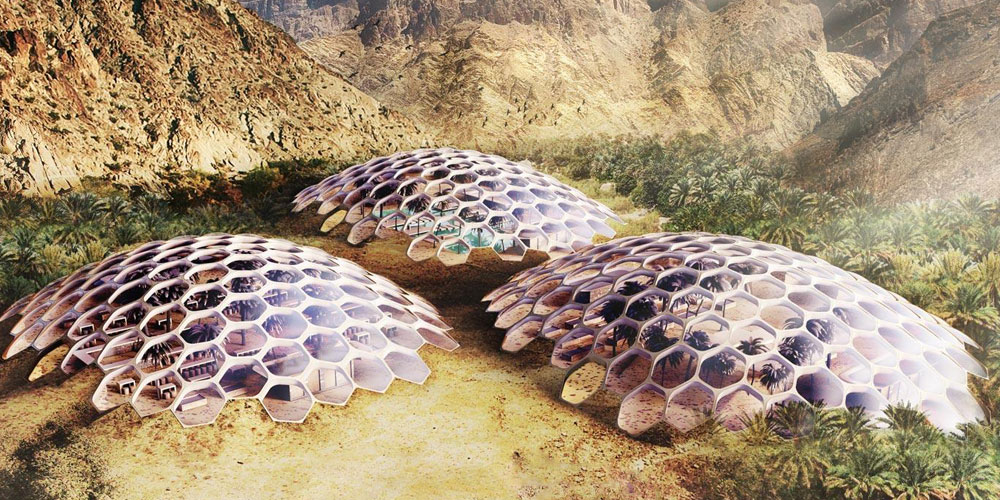
Stage four - Scandinavia
The introduction of artificial light and warehouse farming into the Ecroium equation for countries in the far northern hemisphere, where there is a lack of light during the winter months. These S4 blocks are built in Scandinavian countries and the Arctic. Gardens are not required as they get snowed over, and biodomes are pointless for the same reason. These environmental considerations lead to the utilitarian C-block I designed, and banged on about, back in 2004. (we all know how the Scandos love clean, utilitarian design! It's like the IKEA of environment building). To make it work the clever Scandinavians steal the ravings of a madman found on the Internet Archive and develop the rack-farm system 😛 These rack-farms is structured like a server-farm, except the 'blades' are trays full of plants, or bio-soup, grown under LED and later 'sunlight' emission polymer paints. Sunlight paints are used for all lighting, and linked to a standardised central day/night cycle (with override) which cures SAD (Seasonal Affective Disorder) and vitamin D deficiency.
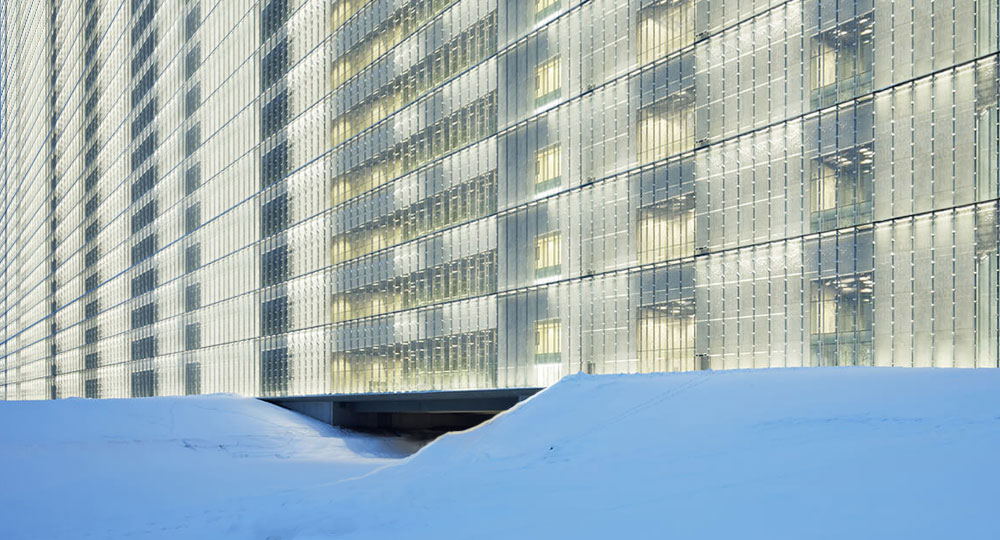
Usually a glass façade buildings, with the outer windowed areas being hab-units, and the inner core of rack-farms, and IT servers. The inner core generates heat to warm the building.
Stage five - Subterranean
The stage four C-Blocks are built underground to protect from nuclear attack. Subterranean, and miles below the surface, all interconnected with a (British style) tube system constructed within the grid of the K-Block (kilo-block as it is 1km square). Each C-Block is a standardised 300m cube. This military specification becomes the standard for civilian habitats moving past the 22nd century. Where these complexes are built: the surface returns to mother nature.
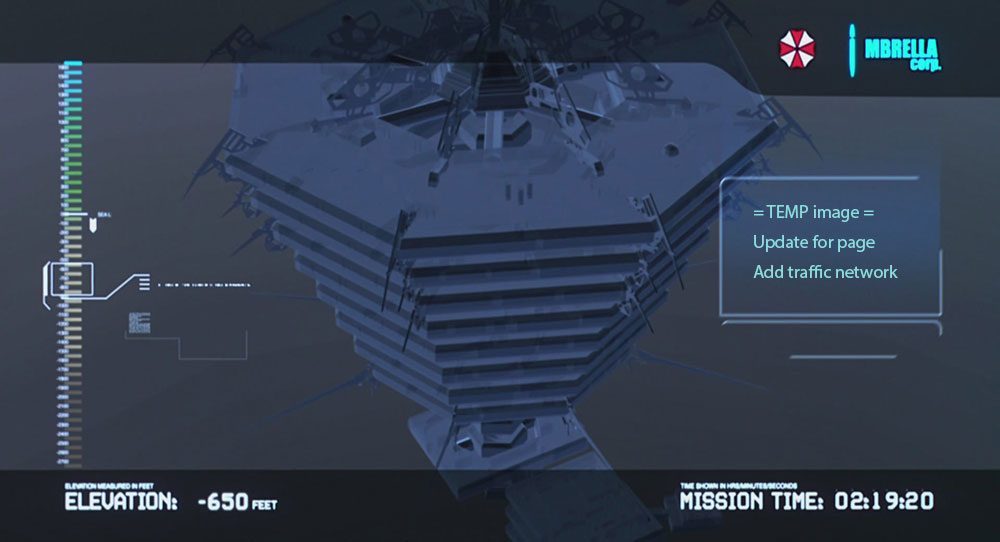
hmm, this probably needs a underground schematic for the final page, like the umbrella corp.
Nuke proof bunkers have long tunnel entrances with right angles to reduce the force of impact on heavy blast doors. However, these blast doors are not 'nuke proof', even the ridiculously thick doors of Cheyenne Mountain complex would not stop a direct hit. This was solved with the 'a tube train on a track' system that completely fills the entrance tunnel. The train is constructed to relatively tight tolerances, with clamp seals, and the carriages are filled with sand to absorb energy. After a nuke strike, the inhabitants do not come out (as the entrances would be known to the enemy, and leaving would mean they are sitting ducks as they exited). Instead, they stay put... for years. Any counter-strike is nuke based, and ground forces are repelled with remote-controlled drones, or illegal sentient killing machines (SKM) developed by the corporations black-ops. When, and if the war is won, the inhabitance can dig their way out, through prepared sand filled tunnels. However, most do not go to the surface unless they have to for work, and then most prefer to run around the surface in a drone.
Stage six - Off World
Seal it up and transport it off world. Brute force terraforming with C-Blocks built by sentient machines (pre-cursor of the Artiloids) on distant worlds. This is where VotNF ends, and Sciror begins.
Plan 1
Time to start sorting things out. The basic idea is to collect three separate backgrounds together under one umbrella of 'Philverse'. These three being 'Philhammer', 'Sciror', and 'Visions of the Near Future'. These all link to each other and build upon each other. Visions of the Near Future lays the foundation for Sciror, which in turn lays the foundation for Philhammer. In effect, they are all one setting, with a timeline divided into three eras. This setup means you can start from Philhammer and drill all the way down to Visions of the Near Future and end up here, in the present day.
Philhammer
 To make the distinction between Philverse and Philhammer clear: I'll be referring to my revision of Warhammer as Philhammer. There will be no separate website for 'Philhammer' as it contains GW IP. I'll be updating the articles, and filling out some of the missing details. I have to catch up on a fair bit of background. Philhammer covers the hidden science of 40K, the effects of the Dark Age of Technology has on contemporary Imperial design and culture, and attempt to explain how the 'grimdark' background can make sense to a modern, sceptical, tech-savvy, audience. In grounding 40K in reality, and explaining warp based technologies, it makes it easier to suspend your disbelief - or at least that is my aim.
To make the distinction between Philverse and Philhammer clear: I'll be referring to my revision of Warhammer as Philhammer. There will be no separate website for 'Philhammer' as it contains GW IP. I'll be updating the articles, and filling out some of the missing details. I have to catch up on a fair bit of background. Philhammer covers the hidden science of 40K, the effects of the Dark Age of Technology has on contemporary Imperial design and culture, and attempt to explain how the 'grimdark' background can make sense to a modern, sceptical, tech-savvy, audience. In grounding 40K in reality, and explaining warp based technologies, it makes it easier to suspend your disbelief - or at least that is my aim.
Sciror
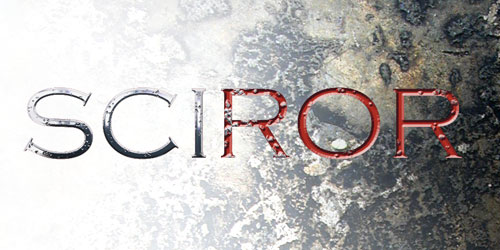 It was pointed out to me by other fans that because 'Philhammer' has so many of my ideas supporting it, that it had become its own setting. So I decided to run with it and develop a background-setting using all the ideas of Philhammer, ripping out all the GW IP, and see what happens. Thus Sciror was created. At its heart, it is a drop in 'replacement' setting for the 'Dark Age of Technology' from 40K but seen from the other side of history and the more positive perspective of the 'Golden Age of Technology'. It details the civilisation before the fall, why the fall happened, and the effects of the fall.
It was pointed out to me by other fans that because 'Philhammer' has so many of my ideas supporting it, that it had become its own setting. So I decided to run with it and develop a background-setting using all the ideas of Philhammer, ripping out all the GW IP, and see what happens. Thus Sciror was created. At its heart, it is a drop in 'replacement' setting for the 'Dark Age of Technology' from 40K but seen from the other side of history and the more positive perspective of the 'Golden Age of Technology'. It details the civilisation before the fall, why the fall happened, and the effects of the fall.
The fall comes about when the machines of the Supremacy leave humanity to their fate after the 'Psidemic' (world altering psionic manifestations). It replaces the popular trope of 'machine betrays man', from films such as Terminator, with 'man betrays machine' (there still isn't the exact tv trope - suggestions in the comment if you have one?).
Things get complicated: In working up this background I realised that: if Sciror could explain 40K tech, then it could explain any sci-fi. A lot of other sci-fi has the same issues as 40K, and I figure other creatives may encounter similar problems while creating their own worlds. So I then changed the concept of Sciror to 'meta-framework' for creating backgrounds. Anyone can create their own background for their setting using Sciror as a springboard for their vision. All the technology is explainable, interoperable, and you can concentrate on the story. If a fan of your narrative wants to know how something actually works, from their modern-day perspective, Sciror explains it. Sciror will still detail human advancement over the centuries, but it's stable, a 'vanilla' core of logical exploration of ideas about the future. All the action happens in scenarios branching off from this core, where events like The Fall become a 'what if'. Here are the 'what ifs' that will serve as an example of backgrounds created with Sciror: 'Stare in the Abyss', 'Psidemic' (The Fall) and 'Twistasy', which I'll be jumping between in a chaotic manner during development.
Displacement Point: The idea of Sciror is to create a 'displacement point'. Instead of using the modern world as our frame of reference, we move our perspective to an imagined point in the future and use that as a basis for storytelling. I think this can work as we live in stories, our perception of the world is a narrative, and we have so many stories through modern media that we can imagine a future world much more easily than in the past. More importantly, when we think of a setting that is incomplete, we quickly fix it by borrowing from other settings to fill in the gaps. This natural ability, and wealth of resource material, means we can create a common 'dreamscape'. A place where all stories come together, and interact with each other, using our common culture. Then we can start designing new stories taking this new 'reality' into account. It will create an unusual situation that if you know 'Sciror', the stories will make sense: in the same way traditional sci-fi references our world, this new sci-fi will reference Sciror. Stories based on stories. Using fiction as a basis for future imagineering. If you do not know Sciror, then it is probably going to be a culture shock as everything is different, and I want to make it different.
Visions of the Near Future
Here I'll be designing and imagining solutions to today's problems. Which will act as a springboard for Sciror. These solutions create the base narrative, the foundation, onto which I'll raise Sciror. By designing for the 'here and now', we can create narratives that are restrained by reality, and hence more believable. Anyone can judge the designs and see if they accept them. For example, if I design hab-unit: you can quickly decide if you would want to live there or not. If you do, and you think the design is a good idea, then you are 'hooked'. Then it's time to reel you in. Once your logic accepts the premise, it is much harder to put the brakes on, and then we are on the Philverse train to the future. At least that is the plan.
This all means you can start at Philhammer and follow the logic, and narrative, all the way back through history and end up in the here and now: looking at designs for our modern world. The reverse will also be true, that you can start from here and end up in 40K. I mentioned hab-units, and I think that is the first thing to tackle, as living space is so personal. You will know if you like it or not. I'll post my stages of Ecorium development, as this spans all era, and see how it takes. Will it hook?
Back again
It's been a couple of years since I last posted on my blog. I had to step away due to family commitments. Now that my role as a carer is coming to an end, I find myself thinking about Philverse, Sciror, and WarSpike more and more. Lots of ideas have been running around in the back of my head while I've been away, no matter how much I tried to suppress them, and they are starting to bubble up to the surface. They need to be expressed; otherwise I'll explode, so I've starting to work them up.
As part of my Near Future designs, the first stepping stone of the Sciror timeline, I want to touch upon architecture, psychology and politics. Before I went on hiatus I started to think about these things, and how to lay a foundation unto which I build and justify the setting. My CORR housing post was my first outline of how to deal with a housing crisis in Britain, and how to build on the green belt land. I rendered up this image a couple of years ago;

These are 1-bed CORR hab-units, around 50 sq.m. (current UK minimum), along with a garden, built over the road, with commercial space inside, and parks outside. Using the real world as a basis for the design constraints the solutions, and forces creative thought. In being designed for real-world situations, they can be judged by anyone, and if they seem reasonable, they will be more believable. The idea is to make it easier to suspend disbelief and draw the reader in. We can then use these as a springboard for future developments, as it all leads to the Ecoria concepts. The nuke proof Ecoria are an extreme idea, they can be hard to accept, so I want to show the steps of how we get there.
Read the rest of this entry »The Machine Economy
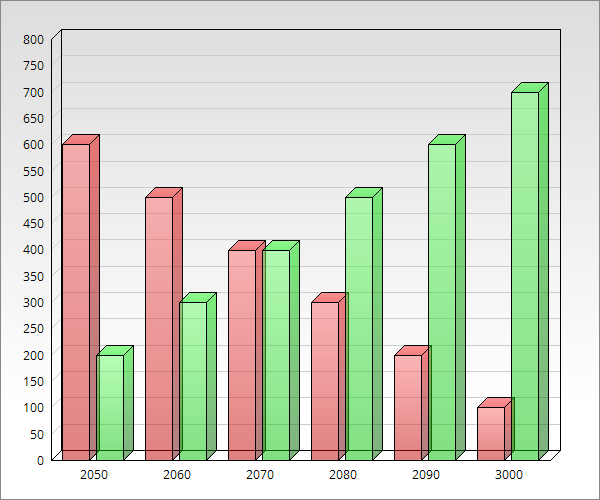
Business is stuck in the mindset that if you cut the pay of your workforce: you gain a competitive edge (as you can reduce costs). Which is true. This usually happens during an economic downturn with an increase in labour. However, as soon as all businesses follow suit you lose this competitive edge. The problem with this stratagem is that the workforce are also customers. When you cut the pay of your workers: you are also cutting the amount of money customers have to spend. This will lead to a decline the economy. What was once a sneaky ruse to gain an edge (which worked so well in the beginning) ends up as 'standard practice'. Which unfortunately leads to the whole system degrading. It then becomes very hard to buck this downward trend. If a decent company decides to pay good wages this will increase the money their workforce has to spend. This, in turn, will increase customer demand. But often this demand will be for other company's goods. (Unless the workforce spend all their money with their employer!) If other companies do not follow suit: the decent company will end up in trouble. (As the cost of its products increase.) In reality, this rarely happens: hence to battle the downward spiral we have the 'Minimum Wage'.
Businesses now have enough experience to realise they cannot get out of the wage reduction drive. Even with government intervention on the minimum wage, business always looking for the next way to cut costs and regain the edge. (Gain an edge for a short while until everyone else cottons on.) This is where the idea of out-sourcing, moving manufacturing to other countries, comes into play. Taking advantage of the lower cost of living in a developing country to reduce costs relative to the original country. The problem is the same as before: soon everyone does it, and their competitive edge. But now the company is paying workers in another country, and the customer base in the original country shrinks further. To further compound the suffering: the government (of the original country) does not receive any tax from workers in far away lands. Combined with the loss of jobs in the original country, shrinking VAT income from sales as the customer base collapses, along with increased benefits payment, leads to the whole lot heading on a downwards spiral.
Read the rest of this entry »British Vote System

I am not a fan of the first past the post system we have in Britain, as it does not properly represent the will of the people. Other systems such as the Alternative Vote, Party-list proportional representation, Single Transferable Vote, or hybrids like Mixed-Member Proportional Representation, do not really appeal to me either. They are better in some aspects, but introduce other issues down the line and can become very complex when scaled up. Instead of going into all the things I think are wrong with them, I thought I'd put up my mind to designing a new system, after all it's really no different to designing war games: a set of rules to figure out a result. What follows is the result of these thoughts, and new system I christened: (new) British Vote System or BVS. I like the idea that the system should be named after Britain, but I'm open to a 'technical' name if you can come up with one?
This idea is to have local constituencies, but also a form of proportional representation for Westminster, along with getting the most powerful voices in the cabinet, and coalition governments the norm. Here's how BVS would work;
Read the rest of this entry »COR housing
Following on from my earlier post 'Future Perfect', I want to start to layout the argument for my vision. Construction Over Road/ Rail Housing make use of the wasted space above roads and rail systems. The idea is to better manage space in countries will high population densities, with an aim to maximize 'nature space'.

Nature space is any outside space that has direct access to the sun. This is perfect for plants, and studies show that humans enjoy nature far more than concrete jungles. Modern city design eats into this nature space and removes nature space from people's lives. If you take a satellite image of central London all you'll see is roads, pavements, and barren roof tops. We need roads but they're hardly human friendly once you step out of a car. Most roofs a not used by humans at all, and devoid of life. Pavements are also needed but not much of a joy more utility. But if you do not have a car: it seems most would prefer to walk/ cycle through a park (away from the fumes, noise, and traffic chaos).
The problems with modern city design are endless. As London develops the limitations of traditional architecture start to show. The more skyscrapers you put in: the more you'll overload the road system. Even cities like New York, with very wide roads, have ground to a virtual halt. This is due to the amount of traffic needed to get people and goods to all those skyscrapers on a daily basis!
There has to be a new way to look at city planning, or more specifically housing. In the ye old days it made sense to build a house by the side of muddy track. There was plenty of nature, transport was by foot, horseback or carriage (pulled by horses), and humans had plenty of fresh air. Even in the early city: the industrialists built terraced houses beside narrow roads that saw little traffic. Children could play outside and were rarely interrupted by horse or cart. All that is gone.
Read the rest of this entry »Mega York 1
I've added an image below of 'Mega York 1' to the Ecopolis page. The idea is to get across the sheer scale of a 300m x 300m cube if built in a modern city like New York. They are massive, like the Mega-Blocks of Judge Dredd only bigger. The main difference is population density: a mega-block in 2,000AD can house 75,000 citizens while an Ecorium can house a mere 2,160. This does not take into account infrastructure to support the block, and where the 2,000AD mega block needs supply lines for food etc. the Ecorium is basically a massive farm and relatively self-sufficient.
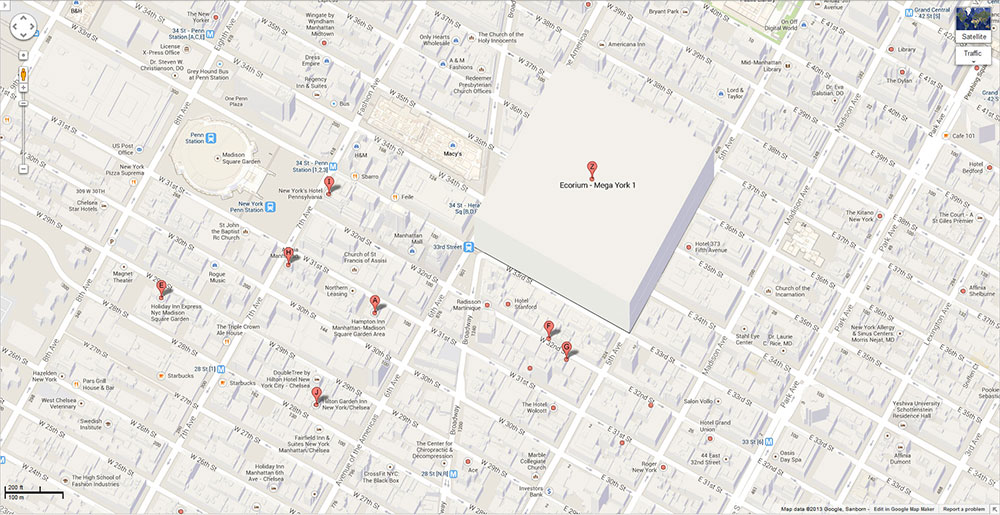
Earth in 40K is covered with these buildings, along with double, and triple, stacking the population of Terra would be in the trillions. The tops of the Ecorium create a new planetary surface onto which all the gothic architecture is built, the upper surface is for the pilgrims and worship of the Ghod Emperor.
Future Perfect
So I'm pushing forward with the Sciror stuff, and deep thinking about the future of civilization (always fun) and its impact on the world. While Ecorium designs make a lot of sense (to me), and it's true I could simply leave it at that and say 'the machines did it', I thought it would be more fun to imagine some evolutionary pre-steps invented by humans to reinforce the idea that the machines gave us what we wanted. In rethinking architecture I need new some tools to explain how it all works, to communicate to the masses why this is a good idea. I came up with 'Blocks Space Diagrams' ;

You can read more about it here: Block Space Diagrams
This then leads to idea about how to design future building by giving a clear idea of our design goals. To really change the collective vision of what a future city will really looks like. This lead to me playing about in Blender to create the basics;
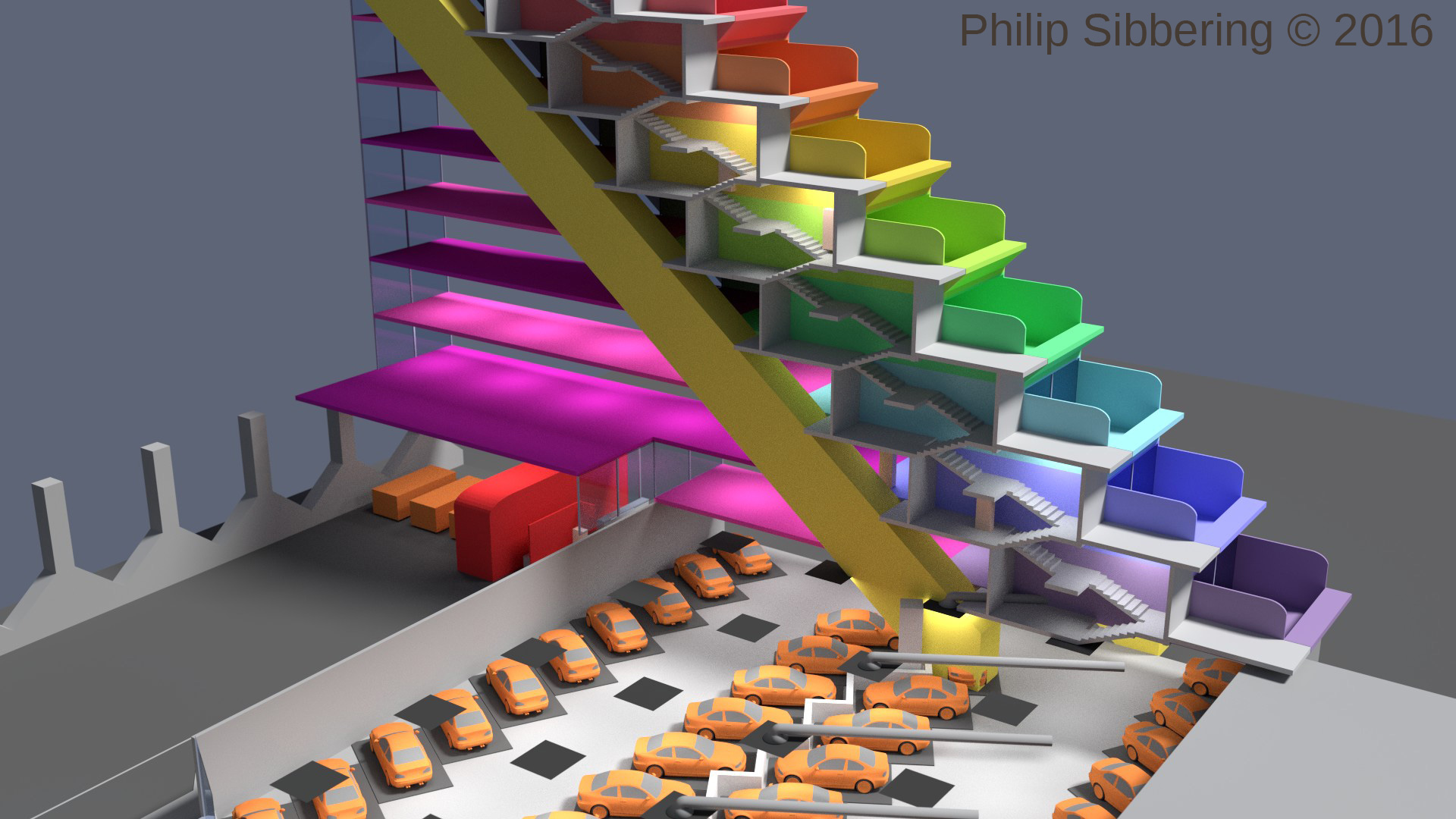
This is a cut away of one half of the design, a slice through the structure. It shows the staggered stacking of the units (like an Aztec pyramid!), the 'hill lift' to account for the slope, and the layout of the car park and roads. All very compact and build around a steel frame with fireproof pre-fab panels. Each hab-unit is sound isolated from the steel structure and neighbours. Each hab-unit has its own walled garden where privacy is paramount (hence the high walls and end of garden overhang (stops people above looking into a downstairs neighbours garden)). Security is build into the design. A very safe environment. The slice above also shows the emergency stair system, build on top of the hill lift, and implemented every 10 units across.
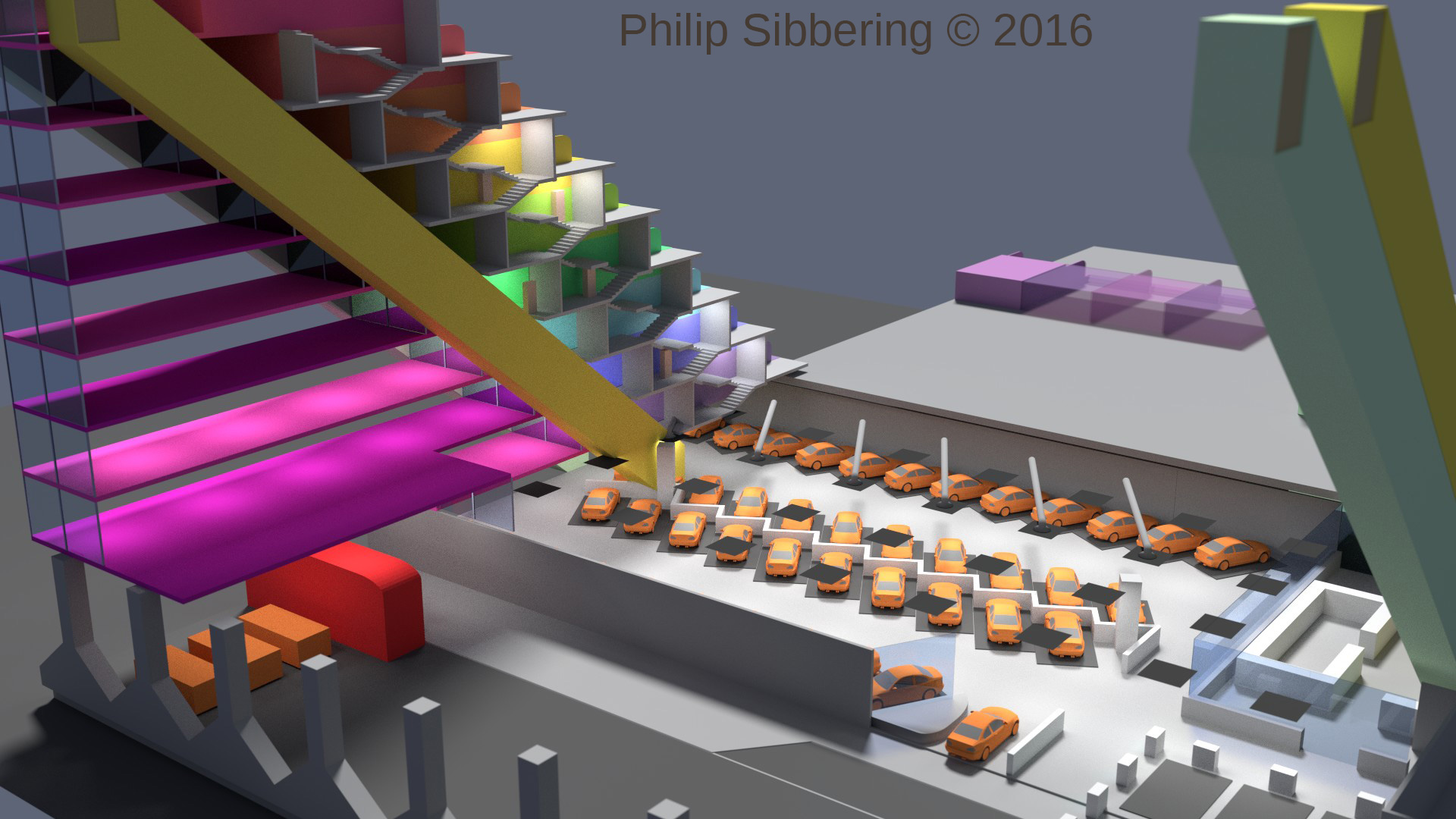
The purple space is 'commercial' as is where we can put shops (who like to control the light to best display product), the early version of rack farms to grow food within the city, or data-centres where the heat can be recovered and pumped into the hab-units in winter, or power air-conditioning in the summer. The space in the back, the large grey area covers more car park, but on top would be a garden part exclusive to the residents (more security).
The problem with sky scrapers, and building up people density that way, is supplying them - infrastructure has to increase dramatically and often road and rail systems will be overwhelmed as more and more sky scrapers are built. New York has very wide roads (compared to London) but it's grid locked. London couldn't have sky scrapers in the numbers like that have in New York else the road and rail system would fail. When we did build a group of sky scrapers in London we had to build the Docklands light railway system so people could get to Canary Wharf.
With my design we can population density without over stressing the populace because it's making use of the wasted area above the road space, and also adds a ton of secure off-road parking. This design is perfect for large roads leading into cities, or around cities like the M25. I would cover all 188km of the M25 (modern steel beams can easily span a motorway). With each 18 block slice being 6.5m wide, that's 507,600 units. Later they can be extended into the cities with redevelopments. When I walk around London I see a ton of unused space above the roads. A wasted opportunity. Further, we can also convert some of the commercial space (shown above) into light road ways for cycles and electric vehicles. We could have double or triple-decker roads, perhaps with rail and underground systems beneath, which eventually leads to the stacked rail system of the Ecorium. We could also use the blocks to route electricity, and fibre optics.
40mm wall parts - redo
These are the replacement prints I received from materialise-onsite.com printed up on "SLU machines (high-definition, they build at the same resolution as a Vipr machine) in the grey Xtreme material" which sounds impressive. They are far better than the first lot of PolyJet prints they sent out, but these new ones are a bit of a mixed bag.
The new prints are far crisper, with the square edges, very and smooth flat horizontal, and vertical surfaces - being almost perfect. Unfortunately the sloped sides are stepped, and while the steps are clean and precise, they are still steps. In the last 5 images you can clearly see what I am talking about, and at 28mm scale this is far too obvious (the mould, and final cast, will duplicated this stepping). This stepping would really show up if the wall parts were painted and then dry brushed. Also in the last 3 you can see how bad the white printed parts really are.
If I have a project without any slopes or curves it may be an ideal process and I will bear this process in mind should that come about (I might use it for future 'base frames' which are basically the floor part without the grill, so all flat sides and no slopes. I'd physically sand the edges to get the bevel rather than print it up).
I have asked materialise-onsite.com if I can have a refund if they cannot do 16µm - that is what was on their website, and that is what I want.
Org Concepts
I have been messing about with the Org concepts some more. I came up with one I liked in a doodle while on the telephone. Funny how inspiration strikes when you are not really trying! I scanned the scrap of paper into Photoshop and worked it up. The Orgs are the Sciror version of Orcs, but I wanted them to be even meaner looking (if that's possible), a mix between 40K's Orks, rage zombies (from 28 days), and a dash of crocodile. Notable differences are the lack of lips (I may play up the shark teeth angle a bit more in later versions), the skeletal nose, and rounded ears.










